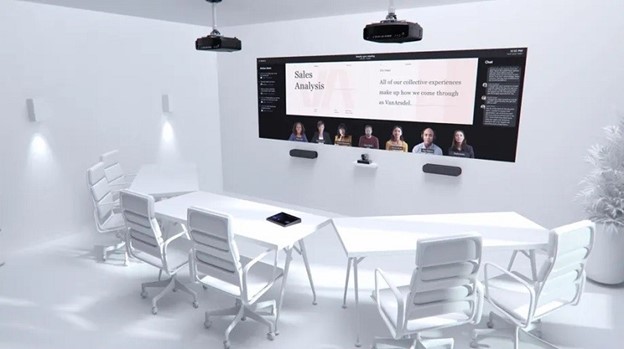Over the last two years, the importance of optimizing efficiency and productivity in the Hybrid Workplace has become an accelerated priority. Technical innovations in automation can help streamline our work, thus saving time, reducing costs and building business resiliency. In the following insight, we discuss how to make hybrid work between people, places and processes simpler and deep dive into some tools that have become integral to improving business efficiency. It’s important to strengthen your resiliency for today and be prepared for what may be next.
People
There is no question that there has been a shift in the workplace over the last two years. One study showed that 80% of managers expected more flexible work-from-home policies post-pandemic. Employees that have been productive from home for many years now feel like they can continue to be effective remote workers due to recent technology improvements. At the same time, employees want flexible remote work and crave social interaction. Those factors can create complexity in managing your employees and determining the technology needed to create an environment with lots of flexibility. Additionally, people working from different areas means that you need to transform several areas of your business processes to support a true Hybrid Workplace.
Your employees are an essential component of your business. We know that hybrid work is here to stay. But how do you create a culture that enables a hybrid world and incorporates your organization’s culture? How do you support this new paradigm of having people in different places?
Over the last three years, a concept that emerged is the focus on “Employee Experience,” specifically about creating an employee experience in the cloud. We always talk about customer experience and digital experience, but an Employee Experience is something new. How do we give our employees the best experience working in that hybrid world?
The answer is that we also must build a listening system. We’ve seen plenty of instances in the Great Resignation where people left the organization because they felt like they were not listened to. Many are exhausted from being in virtual meetings in front of a computer all day long. But we must embrace the flexibility to attract and retain new and diverse talent and teams. Technology can play a significant role in addressing this.
Online Learning
As a knowledge-based organization, like a law firm or a government contractor, retaining your knowledge, learning new skills and ensuring a free flow of information is a priority. How do we give employees an online learning management platform where they can find courses? How do you build online communities among different groups across your organizations?
Previously, in-person learning would require sending someone into a class over a fixed period hoping that they will retain the information. Online learning platforms transform that experience by allowing sessions that you can do at your own time and pace. An example of a Microsoft Teams learning platform enables you to pick classes, schedule them, and help you find the next courses you may be interested in – all directly on the platform.
Viva Insights
Over the last two years, a tremendous amount of technology emerged to help people manage their time better, be more productive, drive a better self, and support their well-being. Microsoft Viva Insights tracks your habits once you opt in. By monitoring yourself, you can detect patterns and determine where improvements are needed or if there is a possibility of burnout in your daily habits. One feature to consider is automatically scheduling focus time. With this feature, the platform will book sections of a calendar with focus time that will enable “Do Not Disturb” and allow you to focus on the work that you need to get done.
Places
Most businesses have designed their spaces for the people working physically in the offices. With the new age of Hybrid Work, how do we ensure that those working remotely feel as inclusive as those inside your office? A recent trend emerged: companies design their offices inclusive and adequate for hybrid work by transforming the physical space. Some ways to drive inclusivity for your hybrid employees include:
- Implement a system for workspace areas such as a desk or conference room to be reserved in advance and allow managers to track who is physically in the office.
- Collaboration platforms such as Microsoft Teams and Slack drive communication across remote and in-office employees.
- Rethink your conference room to include capabilities for hybrid employees to dial in and engage with in-person attendees. Adjust table seating so that all seats face the camera and video screen. Consider purchasing a portable whiteboard that converts all written material into a digital format.

Processes
The last piece driving efficiency in the Hybrid Workplace is processes. We’ve seen a dramatic shift to the cloud. It’s essential to move to the cloud as fast as possible because that builds resiliency and allows you to be very nimble. As a result, it will enable better security, increased compliance, and true business agility in most cases. To get started, think about the digitalization of every business process, from operations to sales and everything in between, and do that in a scalable way.
Over the last two years, businesses have also implemented a dramatic amount of automation. Helping a company automate paper invoice processing is an excellent example of a process that can transition to automation. A partner like Withum can help you determine other manual processes in your business that can be automated.
Download Guide
5 Manual Processes Organizations Must Replace with IPA
Security
Most organizations should mandate a zero-trust model, where users are not trusted by default – access starts at zero. It is built up gradually by adding additional access points. It’s important to remember that security will drive compliance with federal regulations and is a pillar that your business must adopt and pay attention to.
If your company works with subcontractors or grants access to external vendors, a major security concern is managing identities and access to systems. Think about the benefits of having a system where you can add a subcontractor for a specific period. That person can go into a portal and request access to particular items needed to complete their work. It goes through an approval process automatically, and the business only allows them access for a determined period of time.
Another major security concern is managing devices. We now access cloud systems from multiple devices, and we need to ensure that each one is adequately secured – whether it is a corporate device or a personal device. If a personal device is in use, it’s paramount to ensure that documents are not downloaded to their device.
Automation
Automation is seen as the most significant opportunity for your businesses to build resiliency and drive efficiency and productivity. Anything that can be automated should be automated. If you build in automation, you can sustain crisis after crisis because your business now relies less on manual processes.
For example, let’s say that you have a person in your organization that has an email mailbox. They receive an account payable vendor invoice by email. This person has to open the email, see who it is for, access the accounting system, key in the invoice data, and send that invoice for approval to someone else. It is possible to replace the manual process with artificial intelligence powered by Robotic Process Automation “RPA.” The robot can work on your behalf by going into the accounting system, recognizing the invoice text and typing it in, submitting the document for approval, and repeating the process as many times as needed.
Although it may seem daunting, the transition to automation can be done in small increments. Consider the manual processes you currently have in place at your organization and look at the opportunities where robots can replace this.
4 Tips To Drive Efficiency for Today’s Hybrid Workplace
In this video, Daniel Cohen-Dumani, Partner and Market Leader of Withum’s Digital and Technology Transformation Services Team, explores four tips that will help drive efficiency for today’s hybrid workplace.
Final Thoughts
Creating and maintaining a successful, efficient Hybrid Workplace while staying on top of client commitments, delivering an excellent Customer and Employee Experience and maintaining compliance is no small undertaking. There is a lot to consider. Start with the basics (People, Places, Processes) and leverage technology in security and automation to ensure your business will thrive in a hybrid model. You’ll create an environment that will enable access to flexible communication and collaboration options, make your business secure, and provide better tools for productivity – all of which are critical to thrive in today’s hybrid work environment.
Contact Us
For more information on this topic, please contact a member of Withum’s
Digital and Technology Transformation Services team.





